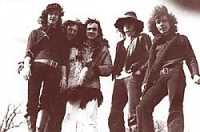VAN DER GRAAF GENERATOR created a number of reputations to live up to - and down - in the course of their passage(s) across the planet as an ensemble. Loosely tagged with the 'progressive' label it was one which fitted them somewhat uncomfortably. At a time when electric guitar was commonly seen as an essential part of any line-up, Van der Graaf' had none, their front-line assault consisting of organ (heavily modified) and Jackson's saxophones - sometimes doubled-up, and for the most part electric. After the departure of Nic Potter, mid-way through the making of 'H to He,' the instrumentation became even more bizarre in both look and content, as Hugh Banton supplied bass on organ pedals. Live performances were often an electric maelstrom, punctuated by Hammill's extreme singing and Evans' sturdy drumming; but beneath the sonic attack could be traced lines drawn from jazz, classical, electronic, blues and soul influences. No satisfactory answer to the question "What kind of music do you play?" could ever be found; then, as now, that music had to speak for itself. In the studio the aim was never to reproduce the live sound of the band exactly. In the days when state-of-the-art recording was 16-track, the group went for the creation of aural landscapes with overdubbing and effects: their use of jagged and surprising time signatures and constructions ideally suited the employment of such techniques. Nonetheless, some effort was always made to capture something of the live power of the group. 'Darkness' 'Killer' and 'Man-Erg' were long-time staples of Van der Graaf concerts at various times, while 'Pioneers' and the epic 'Lighthouse-Keepers' show the group at their most developed as a recording entity.
In 1972, after the recording of 'Pawn Hearts' and an almost endless round of touring in Britain and Europe, the first era of Van der Graaf history came to an end, the group breaking up at the very moment they seemed poised for wider success. Ultimately, though, this was not the end of the story...
In late 1974 the members who had separated after 'Pawn Hearts' decided that the time was ripe - and, more importantly, the spirit between them was right - for a reformation. Soon they were locked away in Herefordshire engaged in rehearsal and the building, preparation and customisation of equipment. This time around, Ham mill was to play electric guitar, and Jackson's electric saxophone set-up was vastly enhanced; Banton, meanwhile had conceived of, and proceeded to build, an organ of revolutionary design. This was eventually late ... and magnificent.
From the outset of this second phase of the group's life, they refused to tread water or attempt to mimic past glories, preferring instead to press on with new explorations. After years of playing together their understanding of each other's music verged on the telepathic, and there was a wealth of new material to perform. In little over eighteen months of incandes-cent activity three albums were recorded: 'Godbluff,' 'Still Life' and 'World Record.'
In the end, the pace -of output, or work... and of adventures too varied and crazed to catalogue - proved too much, and Banton and Jackson decided Van der Graaf Generator to quit life as full-time musicians. This led to the return of Nic Potter on bass and, in a move typical of the Van der Graaf spirit, the replacement of organ and saxophone with solo electric violin in the hands of Graham Smith. In this line-up the band recorded 'The Quiet Zone, the Pleasure Dome.' Shortly thereafter; Charles Dickie joined on cello and synthesiser. This new form saw the group through to the recording of the double live set 'Vital' before, out of money at last, but with principles, honour and spirit intact, Van der Graaf played its last concert in 1978.
"And what kind of music do you play?" They never had an easy answer.
(From 'First' and 'Second Generations' CDs booklets)
